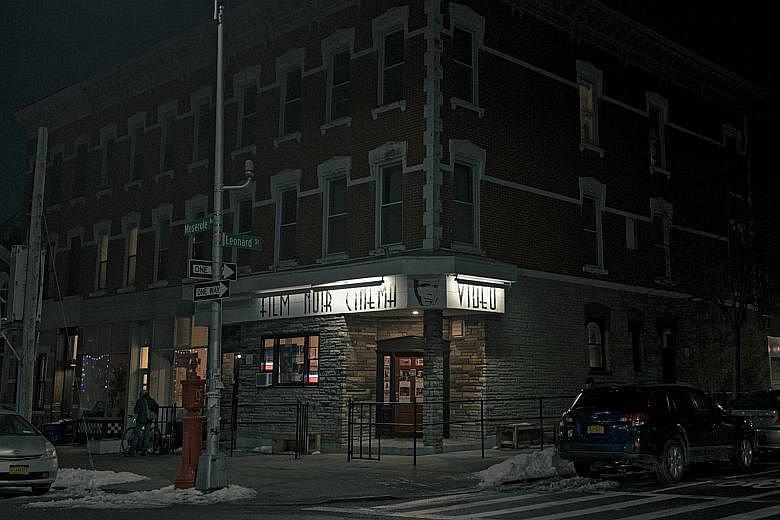NEW YORK (NYTIMES)- A figment of H.P. Lovecraft's wicked imagination, Miskatonic University is the Harvard of his horror stories. It appears to be a typical New England college, but elements of the occult are never far from the surface.
In contrast, at the Miskatonic Institute of Horror Studies, which takes its name from the fictional university, frights are the reason it's alive.
During a recent class in the darkened hall at Film Noir, a Greenpoint, Brooklyn microcinema that houses the real Miskatonic, the topic was Penda's Fen, an obscure 1974 film about a sensitive boy who has encounters with an angel and a crucified Jesus. A ghost light illuminated the instructor's face.
Formed eight years ago in Canada but now existing in branches in New York and London and one set to open this fall in Los Angeles, Miskatonic is the brainchild of Kier-La Janisse, a film writer and programmer. Janisse started it after she grew tired of people dismissing horror "because they thought it was for complete morons," as she put it.
The institute has operated out of its current Brooklyn location since September, offering courses led by writers, scholars, directors and others with a passion for the genre. This spring, classes in New York are about 2 1/2 hours, and cost US$12 (S$15.90)(in advance), US$15 (at the door), or US$50 for a semester pass. Teachers are paid. There are no homework assignments or tests, and students who attend every class both semesters are considered graduates.
"When I was a teenager, I hated school," Janisse, who lives in Toronto, said. "But I read Lovecraft and became obsessed with this idea of how we romanticised academic life, with scholars that worked in libraries and solved mysteries. It made me want to go back to school." Janisse, the author of House of Psychotic Women, about female neuroses in horror films, runs the Brooklyn Miskatonic branch with the writer Joe Yanick. In addition to exploring film, classes this semester will also cover the novelists John Gilmore and Shirley Jackson, and the preservation of genre cinema.
The Miskatonic course calendar would look at home in any film studies curriculum; its next class, on Feb 13, is called Black Horror: The Revolutionary Act of Subverting the White Gaze. Its scholarly approach follows decades of horror studies that have produced influential texts like Carol J. Clover's Men, Women, and Chain Saws: Gender in the Modern Horror Film. The field has its own journal, and there are stand-alone courses and webinars on the subject. But the institute is unique in its all-horror focus.
Sukhdev Sandhu, who taught the class on Penda's Fen, said the school was an example of "underground scholarship." "People are creating spaces in their living rooms affordably and cheaply in order to create a different model of education, and Miskatonic is part of that," said Sandhu, an associate professor of English at New York University, where he runs the Colloquium for Unpopular Culture.
But Miskatonic is also tapping into the golden age of horror in the wider culture, propelled in part by the Oscar-nominated films Get Out and The Shape of Water. Adam Lowenstein, a professor of English and film and media studies at the University of Pittsburgh, cited Miskatonic as one of many passionate players in "a watershed moment for the study of the horror film." This fresh academic embrace dovetails enthusiastically with the new vogue for horror, which hasn't resonated with such urgency since 1968, the year of Night of the Living Dead and Rosemary's Baby, Lowenstein said.
"To understand the change, it would be like if Night of the Living Dead got an Academy Award nomination like Get Out did," said Lowenstein, the author of Shocking Representation: Historical Trauma, National Cinema and the Modern Horror Film. "That's mind boggling, and thrilling," he added.
What's different now is a new generation of horror filmmakers who are hitting the raw nerves exposed by current social movements. A feminist critique of horror has long been a staple of horror studies, thanks to the genre's fixation on male villains and female victims. But with Jordan Peele's Get Out, a Twilight Zone-style indictment of liberal racism, it's race that's most prominently capturing scholarly attention.
The writer Dianca London Potts, who is teaching Miskatonic's Black Horror class, said Peele's film was a sobering conversation starter.
"The movie creeped me out in a way I haven't experienced since the original The Hills Have Eyes," she said, mentioning Wes Craven's 1977 exploitation shocker about a family terrorised by psychopaths. "There's something so terrifying about what we do as a people. Now because of Get Out, people are willing to sit with being uncomfortable." And that, Janisse said, is good news for Miskatonic and its quest for a "balanced education" of history, theory, production and, perhaps most important, community building.
"A lot of us come from a place where horror was maligned," she said. "But in the classroom, people are enthusiastic about horror."
Derek Boeckelmann of Brooklyn, a student in the Penda's Fen class - his third at Miskatonic - said he grew up watching horror movies. A film studies graduate of the University of California, Santa Barbara, he said horror is being taken more seriously in part because it's where box office success meets the political consciousness of the Black Lives Matter and #MeToo movements.
"There's this spotlight on horror because the genre is good for a lot of the social stuff, like Get Out," he said. "It's a great genre for female directors and writers." And for parents who question the validity of a film studies class: Lowenstein said it could be quite beneficial.
"Because horror films have a vocabulary for the horrific, the painful, the traumatic, the things we don't want to look at or see or think about, they really give us an invaluable opportunity to understand and perhaps change the things in ourselves and our society that need changing," he said. "Horror is healthy."

